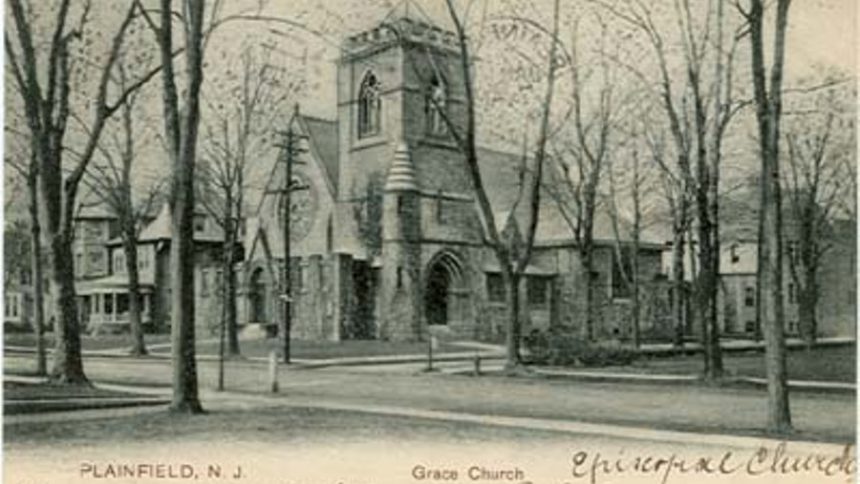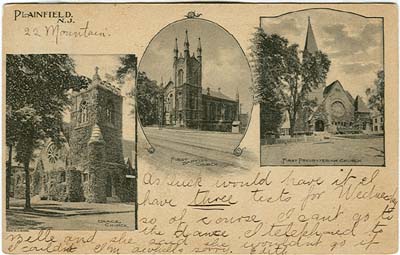What is now Grace Church began on January 11, 1852 when a small group of Episcopalians met for the first time at the Plainfield home of one of the founding members. The second service was held two weeks later. Soon, worship was being held every Sunday morning in private homes and schoolhouses. The number of worshipers increased so steadily that by June of that year, the church leaders began the process to establish an Episcopal Church in Plainfield.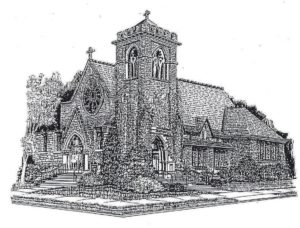
On April 18, 1853, St. Mary’s Episcopal Church (which is now called Grace Episcopal Church) was officially born in Plainfield. Three months later, the cornerstone of the church edifice was laid at East Front Street between Richmond and Berckman Streets in Plainfield – land the church had received as a gift – and construction was completed by early autumn.
As Plainfield and the church expanded over the next decades, the church leadership saw that their building at its current location was inadequate. So they bought a site in the then-posh uptown neighborhood of Seventh Street and Sycamore Street (now Cleveland Avenue) and the original building was relocated to the current site. The removal and reconstruction of the old edifice was completed during the summer of 1876, and the congregation worshiped in the “new” church for the first time on October 15, 1876.
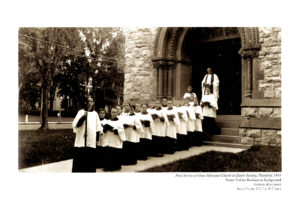 With the completion of railroad connections to New York City, Plainfield became a populous commuter town. The new – and newly-affluent – families joining Grace Church made a new and even larger church building not only a necessity, but also financially feasible. They turned to renowned architect R. W. Gibson, who was also responsible for several historic landmark New York City buildings, who designed Grace Church as a stone Gothic Revival structure with carved red sandstone trim and hints of the Romanesque.
With the completion of railroad connections to New York City, Plainfield became a populous commuter town. The new – and newly-affluent – families joining Grace Church made a new and even larger church building not only a necessity, but also financially feasible. They turned to renowned architect R. W. Gibson, who was also responsible for several historic landmark New York City buildings, who designed Grace Church as a stone Gothic Revival structure with carved red sandstone trim and hints of the Romanesque.
In design and workmanship, Grace Church reflects late 19th century ecclesiastical architecture. The building is a two-story cruciform plan Gothic Revival style, characterized by the use of asymmetry, cruciform plan, pointed arched windows and arches, gothic style door carvings, and decorative sandstone trim around door and window openings. The church has a central nave flanked by narrow side aisles. Clerestory windows above the aisles illuminate the interior.
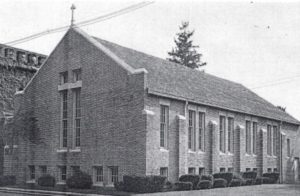 On May 5, 1891, the cornerstone of the new church was laid. By spring, the building was finished. The congregation worshiped in the new church for the first time on Easter Sunday, April 17, 1892. In just 40 years, Grace Church Plainfield had become one of the largest and most influential parishes in the diocese.
On May 5, 1891, the cornerstone of the new church was laid. By spring, the building was finished. The congregation worshiped in the new church for the first time on Easter Sunday, April 17, 1892. In just 40 years, Grace Church Plainfield had become one of the largest and most influential parishes in the diocese.
The Parish House, constructed in 1905, was expanded in the 1950s. The old Parish House was changed into five classrooms, a curate’s office on the second floor and in the lower level there are classrooms and offices where Plainfield Community Outreach is located, and a large meeting room. The main floor houses All Saints Chapel, Meeting Room, and large parlor where many parish meetings are held as well as Sunday Coffee Hour after the main Eucharist. The Parish House extension, completed in 1956, is a graceful structure of brick with limestone.
The trim, harmonizing architecturally with the old stone edifice, and is full integrated with it.
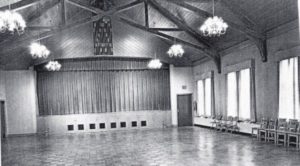 The main floor has an assembly hall named for Dr. Harry James Knickle, the 9th Rector, with connecting kitchen, a ladies powder room and a bathroom. Here on the last five business days of the month, Grace’s Kitchen feeds more than 100 meals daily. At the end of the main floor leading into the church is the Administrative Secretary’s office and the Rector’s office.
The main floor has an assembly hall named for Dr. Harry James Knickle, the 9th Rector, with connecting kitchen, a ladies powder room and a bathroom. Here on the last five business days of the month, Grace’s Kitchen feeds more than 100 meals daily. At the end of the main floor leading into the church is the Administrative Secretary’s office and the Rector’s office.
The Chancel and Sanctuary were enlarged in 1930. Grace Church is now listed on the National Register of Historic Places.
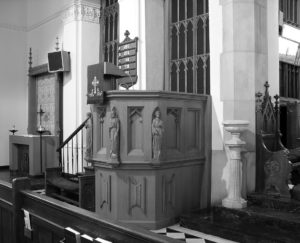 The pulpit of white oak was dedicated on All Saints Day, 1964, in memory of Dorothy Fleming Waring. In niches between the several carved linen fold [panels are the Four Evangelists, Matthew, Mark, Luke and John, which were carved in Italy. At the foot of each figure is a carved symbol of the four Gospels.
The pulpit of white oak was dedicated on All Saints Day, 1964, in memory of Dorothy Fleming Waring. In niches between the several carved linen fold [panels are the Four Evangelists, Matthew, Mark, Luke and John, which were carved in Italy. At the foot of each figure is a carved symbol of the four Gospels.
The beautiful chapel in the South Transept of the Nave is a memorial to Walter C. Scott and dedicated in 1966 designated as the Chapel of Christ the King. Here the priest will bless and anoint the sick of the parish after the main Eucharist on Sunday.
The Ackerman Memorial Garden was dedicated by the Rector, Dr. Harry James Knickle after the 11:00 AM service on Sunday, May 18, 1969. The garden was given by the Ackerman sons in memory of their father and mother , Marion and Sarah Acker-man, who were life-long, devoted and faithful members of Grace Church, The father served as Vestryman and Warden for several decades while Mrs. Ackerman gave her time and generous financial sup-port to all the various groups in the parish. The Building & Mainte- nance Commission oversees the planting and grounds keeping that brings joy and pleasure to all. Today, with the plantings of flowers that attract various butterflies, the garden has been called “the Butterfly Garden.” Parishioners may choose to have their cremains buried in the garden.

